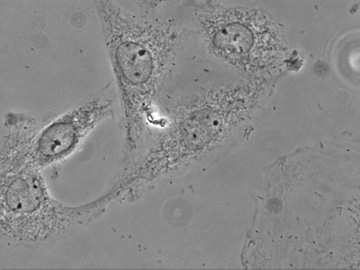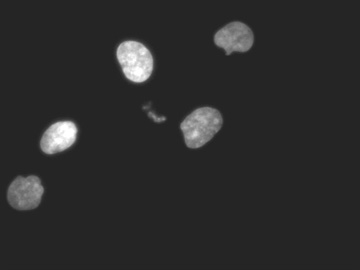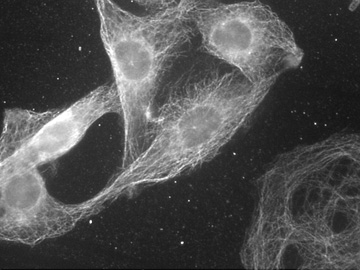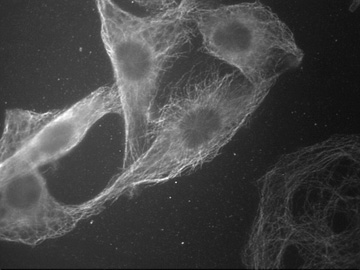Images 4

|
|
 |
Image 4a |
|
Image 4b |
|
|
|
 |
|
 |
| Image 4c |
|
Image 4d |
|
| Images of L8 cells growing on a coverslip. The cells were
fixed, permeabilized, and then labeled with a series of reagents: DAPI (a nuclear stain),
a mouse antibody to tubulin and subsequently an anti-mouse second antibody conjugated to
fluorescein, a rabbit antibody to an intermediate filament protein known as vimentin and
subsequently an anti-rabbit antibody conjugated to rhodamine. The first image (4a) is a
picture of the cells seen in phase contrast. The nuclei, nucleoli, and structures within
the cytoplasm are visible. Note how the cells appear rather fusiform (football-shaped) and
spread out on the surface of the coverslip. For the second and subsequent images, the
transillumination was turned off and the fluorescent illumination turned on. The second
image (4b) is a picture of the same field viewed through the DAPI filter cube. The stained
objects (the nuclei) appeared blue in the microscope. The third image (4c) is a picture of
the field viewed through the fluorescein filter cube. The microtubules in the cells are
visible. These tubules appeared green in the microscope. Each bright spot over the nucleus
in two of the cells near the center represents a microtubule organizing center. The fourth
image (4d) is a picture of the field viewed through the rhodamine filter cube. Seen here
are the intermediate filaments connecting the cell membrane and nucleus. The filaments
appeared red in the microscope. By switching back and forth between the various filter
cubes, all these objects could be viewed. A colored picture representing the
superimposition of the DAPI, fluorescein, and rhodamine images is presented as image 5. |
|
| Click on any image to return to the previous page. |
|